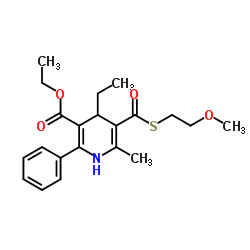MRS 1477
Modify Date: 2024-01-08 15:35:29

MRS 1477 structure
|
Common Name | MRS 1477 | ||
|---|---|---|---|---|
| CAS Number | 212200-21-0 | Molecular Weight | 389.51 | |
| Density | 1.1±0.1 g/cm3 | Boiling Point | 532.4±50.0 °C at 760 mmHg | |
| Molecular Formula | C21H27NO4S | Melting Point | N/A | |
| MSDS | N/A | Flash Point | 275.8±30.1 °C | |
Use of MRS 1477MRS 1477, a dihydropyridine derivative, is a positive allosteric modulator of TRPV1 in the presence of capsaicin. MRS 1477 itself does not induce apoptosis, but the co-existence of MRS 1477 and capsaicin can induce apoptosis[1][2]. |
| Name | Ethyl 4-ethyl-5-{[(2-methoxyethyl)sulfanyl]carbonyl}-6-methyl-2-phenyl-1,4-dihydro-3-pyridinecarboxylate |
|---|---|
| Synonym | More Synonyms |
| Description | MRS 1477, a dihydropyridine derivative, is a positive allosteric modulator of TRPV1 in the presence of capsaicin. MRS 1477 itself does not induce apoptosis, but the co-existence of MRS 1477 and capsaicin can induce apoptosis[1][2]. |
|---|---|
| Related Catalog | |
| In Vitro | MRS1477 在 MCF7 乳腺癌细胞中激发 Ca2+ 信号,但在原代乳腺上皮细胞中没有[1]。 MRS1477 (2 μM; 72 h) 与 capsaicine (10 μM) 一起诱导细胞凋亡并增加活性氧的产生和半胱天冬酶活性[1]。 MRS1477 (2 μM) 增加 capsaicine 诱发的 TRPV1 介导的电流密度水平[1]。 |
| References |
| Density | 1.1±0.1 g/cm3 |
|---|---|
| Boiling Point | 532.4±50.0 °C at 760 mmHg |
| Molecular Formula | C21H27NO4S |
| Molecular Weight | 389.51 |
| Flash Point | 275.8±30.1 °C |
| Exact Mass | 389.166077 |
| LogP | 4.01 |
| Vapour Pressure | 0.0±1.4 mmHg at 25°C |
| Index of Refraction | 1.544 |
| 3-Pyridinecarboxylic acid, 4-ethyl-1,4-dihydro-5-[[(2-methoxyethyl)thio]carbonyl]-6-methyl-2-phenyl-, ethyl ester |
| Ethyl 4-ethyl-5-{[(2-methoxyethyl)sulfanyl]carbonyl}-6-methyl-2-phenyl-1,4-dihydro-3-pyridinecarboxylate |